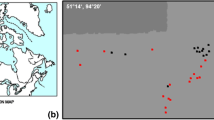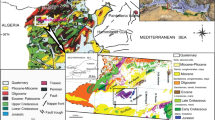Abstract
The notion of a favorability function for delineation of exploration targets has attracted attention among geologists and geomathematicians over the last decade, as indicated by the number of publications on this subject. Traditional estimation methods for a favorability equation carry several ambiguities in the meaning of the estimate. In order to avoid these problems, a special type of geological variable, referred to as the target variable appears in a favorability equation. Explanatory variables are usually physical and chemical descriptors of geologic objects, while target variables are usually available only in best explored regions. A favorability function should be defined as a linear combination of the explanatory variables, while the meaning of the function should be in terms of the target variables. Two objective methods, canonical correlation and weighted canonical correlation, are proposed in this paper. The estimation of a favorability equation by these methods is predicted upon a criterion that maximizes the correlation of the estimate of the favorability function and the target variables. Both methods are demonstrated on a case study of epithermal gold-silver vein deposits in the 2° Walker Lake quadrangle of Nevada and California. Targets for mineral exploration of gold-silver deposits were identified on the basis of the favorability functions by means of optimum discretization.
Similar content being viewed by others
References
Agterberg, F. P., and Gabilio, P., 1969, Two-Stage Least-squares Model for the Relationship Between Mappable Geological Variables: Math, Geol., v. 1, p. 137–153.
Bartlett, M. S., 1947, Multivariate Analysis: J. R. Stat. Soc. (Suppl.), v. 9, p. 176–190.
Chaffee, M. A., Hill, R. H., Speckman, W. S., and Sutley, 1980, Preliminary Data Set Containing Geochemical Analyses of Rock, Stream Sediment, and Nonmagnetic Heavy Mineral Concentrate, Walker Lake 2 Degree Quadrangle, California and Nevada: U.S.G.S. Open-File Rept 80–881, 235 p.
Davis, J. C., 1986, Statistics and Data Analysis in Geology, 2nd ed.: John Wiley & Sons, New York, 646 p.
Ethridge, F. G., and Davies, D. K., 1973, Grouped Regression Analysis-A Sedimentologic Example: Math. Geol, v. 5, p. 377–388.
Fujikoshi, Y., 1977, Asymptotic Expansions of the Distributions of Some Multivariate Tests,in P. R. Krishnaiah (Ed.), Multivariate Analysis, Vol. iv: p. 55–71.
Harris, D. P., 1965, An Application of Multivariate Statistical Analysis to Mineral Exploration: Ph.D. Dissertation, the Pennsylvania State University, Univ. Park, Pennsylvania, 261 p.
Harris, D. P., and Pan, G. C., 1987, An Investigation of Quantification Methods and Multivariate Relations Designed Explicitly to Support the Estimation of Mineral Resources—Intrinsic Samples: Report on Research Sponsored by U.S. Geological Survey Grant No. 14-08-0001-G1399, 200 p.
Harris, D. P., and Pan, G. C., 1990, Intrinsic Sample Methodology:in G. Gaal and D. F. Merrlam (Eds.), Computer Applications in Resource Exploration: Prediction and Assessment for Petroleum, Metals and Nonmetals, Vol. 6, of Computers and Geology Series: Pergamon Press, p. 53–74.
Harris, D. P., and Pan, G. C., 1990, Updated Concepts of Intrinsic Samples and Methodology for Simultaneous Estimation of Discovered Resources and Endowments: Report on Research Sponsored by U.S. Geological Survey, 300 p.
Harris, D. P., and Pan, G. C., 1991, Consistent Geologic Areas for Epithermal Gold-Silver Deposits in the Walker Lake Quadrangle of Nevada and California: Delineated by Quantitative Methods: Econ. Geol., v. 86, p. 142–165.
John, D. A., 1986, Geology of Tertiary Volcanic Rocks in the Paradise Range and Northern Pactolus Hills, Nye County, Nevada [abs]: U.S. Geol. Survey Open File Rept. 86–467, p. 13.
John, D. A., Thomason, R. E., and McKee, E. H., 1989, Geology and K-Ar Geochronology of the Paradise Peak Mine and Relationship of Pre-Basin and Range Extension to Early Miocene Precious Metal Mineralization in West-Central Nevada: Econ. Geol., v. 84, p. 631–649.
Johnson, R. A., and Wichern, D. W., 1988, Applied Multivariate Statistical Analysis: Prentice Hall, 607 p.
Jones, T. A., 1972, Multiple Regression with Correlated Independent Variables: Math. Geol., v. 4, p. 203–218.
Kucks, R. P., and Hildenbrand, T. G., 1987, Description of Magnetic Tape Containing Nevada State Magnetic Anomaly Data: U.S. Dept. of the Interior, EROS Data Center, U.S.G.S., Denver, Colorado.
Luo, J., 1990, Statistical Mineral Prediction Without Defining a Training Area: Math. Geol., v. 22, p. 253–260.
Mardia, K. V., Kent, J. T., and Bibby, J. M., 1979,Multivariate Analysis: Academic Press, London, 521 p.
Mark, D. M., and Church, M., 1977, On the Misuse of Regression in Earth Science: Math. Geol., v. 9, p. 63–75.
McCammon, R. B., 1973, Nonlinear Regression for Dependent Variables: Math. Geol., v. 5, p. 365–375.
McCammon, R. B., Botbol, J. M., Sinding-Larsen, R., and Bowen, R. W., 1983, Characteristic Analysis-1981: Final Program and a Possible Discovery: Math. Geol., v. 15, p. 59–83.
McKee, E. H., and Noble, D. C., 1986, Tectonic and Magmatic Development of the Great Basin of Western United States During late Cenozoic Time: Modern Geol., v. 10, p. 39–49.
Pan, G. C., 1985, Mineral Resources Appraisal on Pegmatitic Ni-Ta Deposits in Fujian Province of China: M.S. Thesis, Changchun College of Geology, 141 p.
Pan, G. C., 1989, Concepts and Methods of Multivariate Information Synthesis for Mineral Resources Estimation: Ph.D. Dissertation, University of Arizona, Tucson, 302 p.
Pan, G. C., and Harris, D. P., 1990a, Quantitative Analysis of Anomalous Sources and Geochemical Signatures in the Walker Lake Quadrangle of Nevada and California: J. Geochem. Explor., v. 38, p. 299–321.
Pan, G. C., and Harris, D. P., 1990b, Three Nonparametric Techniques for Optimum Discretization of Quantitative Geological Measurements: Math. Geol., v. 22, p. 699–722.
Pan, G. C., and Harris, D. P., 1991, Geology-Exploration Endowment Models for Simultaneous Estimation of Discoverable Mineral Resources and Endowment: Math. Geol., v. 23, p. 507–540.
Pan, G. C., and Wang, Y., 1987, Weighted Characteristic Analysis and Its Application to Quantitative Estimation of Pegmatitic Nb-Ta Mineral Resources: Geol. Prospect., v. 23, p. 34–42.
Plouff, D., 1982, Bouguer Gravity Anomaly and Isostatic Residual Gravity Maps of the Walker Lake 10 by 22 Quadrangle, California and Nevada: U.S.G.S. OF Rept. 169.
Reddy, R. K. T., and Koch, Jr. G. S., 1988a, A Generalized Model for Evaluating Area-Potential in a Mineral Exploration Program: Math. Geol., v. 20, p. 227–241.
Reddy, R. K. T., and Koch, Jr. G. S., 1988b, A Case Study of Silver Exploration in Parts of Idaho and Montana Using Mathematical Modeling Techniques: Econ. Geol., v. 83, p. 1008–1014.
Rowan, L. C., and Purdy, T. L., 1984, Map of the Walker Lake 1° by 2° Quadrangle, California and Nevada, Showing the Regional Distribution of Hydrothermally Altered Rocks: U.S. Geological Survey, Dept. of the Interior.
Seber, G. A. F., 1984, Multivariate Observations: John Wiley & Sons, New York, 686 p.
Silberman, M. L., Stewart, J. H., and McKee, E. H., 1976, Igneous Activities, Tectonics, and Hydrothermal Precious-Metal Mineralization in the Great Basin During Cenozoic Time: Transactions, v. 260, p. 253–263.
Stewart, J. H., 1988, Tectonics of the Walker Lane Belt, Western Great Basin-Mesozoic and Cenozoic Deformation in a Zone of Shear,in W. G. Ernst, (Ed.), Metamorphism and Crustal Evolution of the Western United States, Rubey, Vol. vii: Englewood Cliffs, New Jersey, Prentice Hall, p. 683–713.
USGS, 1979a, Aeromagnetic Map of the Hoover-Walker Lake, California: 1 over-size sheet, scale 1:250000, OF Rept. 79-1194.
USGS, 1979b, Aeromagnetic Map of the Mokelumne Areas, California: 1 over-size sheet, scale 1:62500, OF Rept. 79-1233.
USGS, 1981, Aeromagnetic Map of the Dardaneller Area, California: 2 over-size sheets, scale 1:62500, OF Rept. 81-0431.
USGS, 1982, Aeromagnetic Map of the Sweetwater Area, California-Nevada: 1 over-size sheet, scale 1:62500, OF Rept. 82-0066.
Author information
Authors and Affiliations
Rights and permissions
About this article
Cite this article
Pan, G., Harris, D.P. Estimating a favorability equation for the integration of geodata and selection of mineral exploration targets. Math Geol 24, 177–202 (1992). https://doi.org/10.1007/BF00897031
Received:
Accepted:
Issue Date:
DOI: https://doi.org/10.1007/BF00897031




